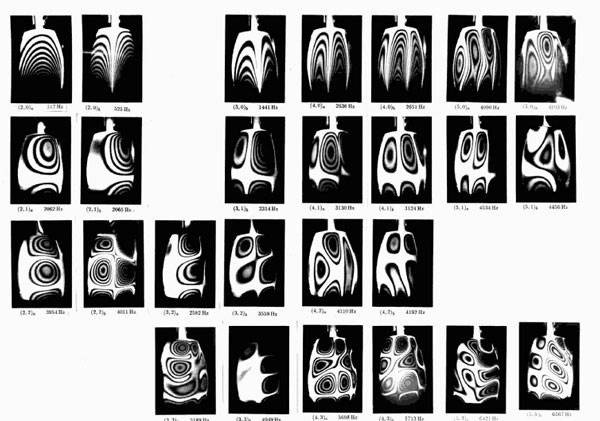Thomas D. Rossing - Rossing@physics.niu.edu
Physics Department
Northern Illinois University
DeKalb, IL 60115
Popular version of paper 4pMU3
Presented Thursday afternoon, May 27, 2004
147th ASA Meeting, New York, NY
Bells have been a part of almost every culture in human history. They are one
of our most cherished musical instruments. Although bells existed in China at
least as early as 1600 BC, only recently have modern scientific instruments
allowed us to understand many of the subtleties of bell sounds.
Among the most notable of ancient Asian bells are the Chinese two-tone bells,
mainly from the Shang, Western Zhou, and Eastern Zhou dynasties (1766 to 249
BC). Chimes of bells were frequently buried in the tombs of royalty and noblemen,
and that is how large numbers of ancient bells have been well preserved through
the ages, including the 65-bell set discovered in the tomb of Zeng Hou Yi in
1987.
 |
In a round church bell or handbell, the principle modes of vibration are customarily
designated by (m,n), where m is the number of complete nodal meridians and n
is the number of nodal circles. In a church bell the principle moes are given
names such as the hum (2,0), prime (2,1), third (3,1), etc. Similar modes are
observed in almond-shaped Chinese bells, but because of their elongated shpae,
each mode becomes a doublet, which are labeled with a subscript a or b in the
diagram below. Thus the bell has two entirely different tones, depending upon
where it is struck.
With the spread of Buddhism from the third century, a new type of large round
temple bell, known in China as fanzhong, developed in Korea, Japan, Burma, and
other East Asian countries as well. These bells are generally considered to
be patterned after Indian prototypes, but few, if any, bells of this age remain
in India. The casting of large temple bells in China reached its zenith during
the Ming dynasty (1368-1620). The largest such bell, cast during the reign of
the emperor Yon-gle (1403-1424), was 4.5 meters high, and its mass is estimated
to be 52,000 kilograms.
The most famous bell in Korea is the King Songdok bell cast during the Silla
dynasty (771), which stands 3.66 meters high and has a mass of 20,000 kilograms.
The round body has a flat protuberance called the dang jwa on which it is struck
by a log suspended on ropes. The dong jwa and other decorations modify the circular
symmetry of the bell, and split the vibrational modes into doublet pairs, but
with a much smaller difference in frequency than the almond-shaped Chinese two-tone
bells. In fact, the pairs of tones, close in frequency to each other, lead to
a slow-beating sound, which is highly cherished in Korean bells. Holographic
interferograms of a small Korean bell are shown below.
 |